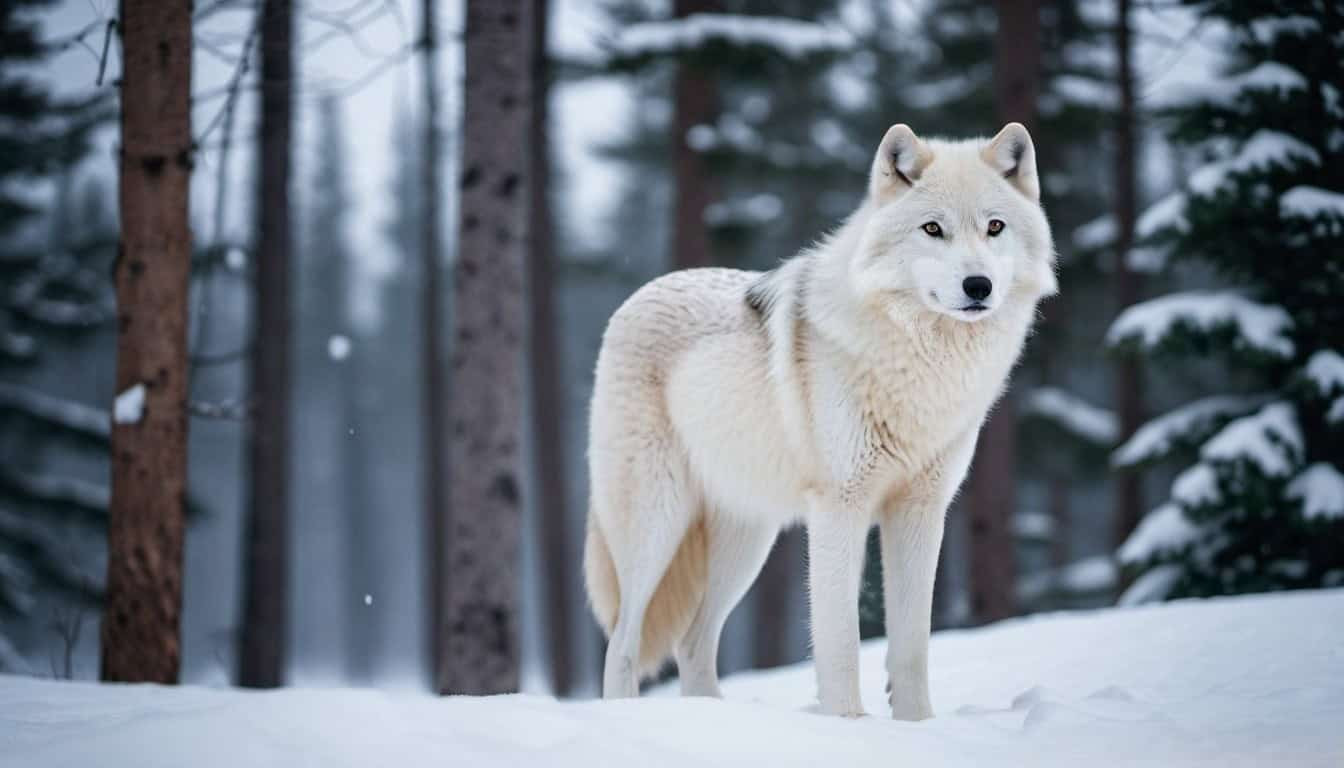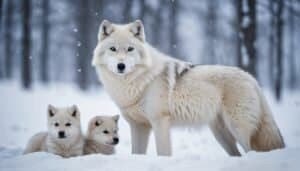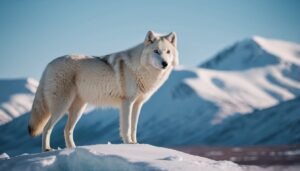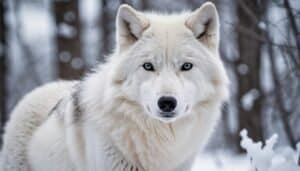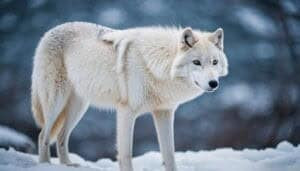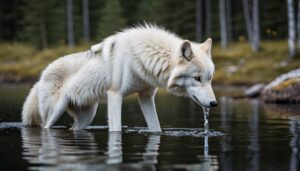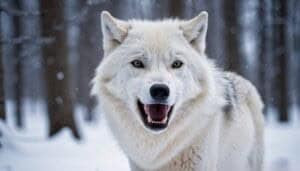Introduction
The Arctic wolf, an iconic predator of the frozen north, has evolved remarkable adaptations to survive the extreme cold of its environment
This article explores the physiological and behavioral strategies that enable the Arctic wolf to combat hypothermia, the genetic traits that support its survival, and the environmental challenges it faces
By understanding these adaptations, we gain insight into the resilience and ingenuity of one of nature’s most formidable survivors
Physiological and Behavioral Adaptations
The Arctic wolf has evolved a range of physiological and behavioral adaptations to thrive in one of the harshest environments on Earth. These adaptations are critical for maintaining body heat and ensuring survival during prolonged exposure to extreme cold
Thick Fur and Insulation
Arctic wolves possess a dense, multi-layered fur coat that serves as an exceptional insulator against the frigid temperatures of their habitat
The outer layer, or guard hairs, is long, coarse, and water-resistant, effectively shielding the wolf from snow and moisture. Beneath this layer lies a thick undercoat of shorter, softer hairs that trap air close to the body, providing excellent thermal insulation
The fur of an Arctic wolf is often about 2 inches thick, significantly thicker than that of other wolf subspecies. This dense coat not only keeps the wolf warm but also allows it to blend into its snowy surroundings, aiding in hunting and evasion from predators
Research has shown that the insulation properties of this fur are comparable to high-quality synthetic materials used in human cold-weather gear (Mech, 1999)
Efficient Metabolic Processes
To sustain body heat in sub-zero temperatures, Arctic wolves have developed highly efficient metabolic processes
Their basal metabolic rate is elevated, meaning they generate more body heat even at rest. This metabolic rate is supported by a high-fat diet consisting mainly of prey like muskoxen, caribou, and Arctic hares, which are rich in fat and protein
A study by Scholander et al. (1950) found that the metabolic rate of Arctic wolves increases by up to 50% in response to cold exposure, a phenomenon known as thermogenesis. This metabolic boost ensures that the wolves maintain a stable internal temperature, even when external temperatures plummet below -30°F
Blood Circulation Mechanisms
Arctic wolves have also adapted their blood circulation mechanisms to prevent hypothermia
One key adaptation is the countercurrent heat exchange system in their extremities. Blood vessels in the legs are arranged such that warm arterial blood flowing from the body core heats the cooler venous blood returning from the paws. This system minimizes heat loss and keeps the paws warm enough to function in icy conditions
Additionally, Arctic wolves exhibit peripheral vasoconstriction, where blood vessels in the skin and extremities constrict to reduce blood flow and heat loss in response to cold. This physiological response helps prioritize the warmth of vital organs and the core body temperature
Hunting and Feeding Strategies
Behaviorally, Arctic wolves adapt their hunting strategies to the extreme conditions
They often hunt in packs, which increases their efficiency and success rate in capturing large prey. Hunting in groups also allows them to conserve energy, as individuals take turns leading the chase and breaking trail through deep snow
In winter, when prey is scarce, Arctic wolves rely on their acute sense of smell and hearing to locate food buried beneath the snow. They are known to dig through several feet of snow to access cached meat or hidden prey
By maintaining a high-fat diet, they can endure periods of food scarcity without significant loss of body condition
Social Behaviors for Warmth
Arctic wolves are highly social animals, and their pack structure plays a crucial role in their survival. During cold weather, wolves huddle together to share body heat, reducing individual energy expenditure on thermoregulation
This behavior is especially important for pups and older wolves, who are more vulnerable to the cold
The pack structure also provides stability and support during hunting and territorial defense. By working together, wolves can effectively patrol and defend their territory, ensuring access to vital resources like food and shelter
Denning Practices
When temperatures drop to their lowest, Arctic wolves seek refuge in dens
These dens are often dug into the ground or snow and are strategically located in sheltered areas away from the wind. The den’s structure provides insulation from the cold, and the close quarters help retain body heat
During the breeding season, dens also offer protection for pups, who are born with a much thinner coat and are particularly susceptible to hypothermia. The den’s warmth, combined with the mother’s body heat, ensures the survival of the vulnerable young during the early weeks of life
Genetic and Evolutionary Traits
The Arctic wolf’s ability to survive and thrive in extreme cold is a result of various genetic adaptations and evolutionary traits that have developed over thousands of years. These genetic characteristics are critical for their resilience against hypothermia and other harsh environmental conditions
Genetic Adaptations to Cold
Arctic wolves have undergone specific genetic mutations that enhance their ability to survive in freezing temperatures. These mutations affect their metabolic rate, fur density, and fat storage, among other physiological traits
One notable adaptation is the expression of genes that control the production of heat shock proteins (HSPs). These proteins play a vital role in protecting cells from stress caused by cold temperatures, ensuring the proper functioning of cellular processes even in extreme conditions
Research has identified several gene variants in Arctic wolves that are associated with improved cold tolerance. For instance, a study by Zhang et al. (2014) found that Arctic wolves have unique variants of the SIRT1 gene, which is involved in regulating metabolism and stress responses
These genetic variations enable the wolves to maintain energy balance and resist cellular damage caused by cold stress
Evolutionary Development of Fur and Fat
The evolution of the Arctic wolf’s fur is a prime example of natural selection at work. Over generations, wolves with thicker, more insulating fur had a survival advantage in the Arctic environment. This evolutionary pressure led to the development of the dense, multi-layered coat seen in Arctic wolves today
The fur not only provides exceptional insulation but also has water-repellent properties, preventing moisture from reaching the skin and reducing the risk of hypothermia
In addition to their fur, Arctic wolves have evolved to store significant amounts of body fat, which serves as an energy reserve during periods of food scarcity and extreme cold. This fat layer provides both insulation and a critical energy source that can be metabolized to generate body heat
The evolutionary adaptation of increased fat storage is evident in the physical condition of Arctic wolves, especially during the winter months when their bodies accumulate more fat to prepare for the harsh conditions
Inherited Survival Behaviors
Behavioral adaptations in Arctic wolves are also influenced by genetics and have been honed through generations of survival in the Arctic. Many of these behaviors are instinctual and passed down from parent to offspring
For example, the tendency to huddle together for warmth is an inherited behavior that enhances the survival of the pack during cold periods. Similarly, the practice of digging dens for shelter is an instinctual behavior that has been reinforced through natural selection
Another inherited survival behavior is the strategic hunting and caching of food. Arctic wolves have developed the instinct to store excess food during times of abundance, which can be crucial for survival during lean periods
This behavior ensures that the pack has access to food even when hunting conditions are not favorable
Environmental Challenges and Hypothermia Risk
Arctic wolves face numerous environmental challenges that can exacerbate the risk of hypothermia. These challenges include climate change, habitat loss, and interactions with other predators and species
Understanding these threats is essential for comprehending the full scope of hypothermia risk for Arctic wolves
Impact of Climate Change
Climate change poses a significant threat to Arctic wolves by altering their natural habitat and affecting the availability of prey
As temperatures rise, the Arctic ice melts, leading to changes in the distribution and behavior of prey species such as caribou and muskoxen. This shift forces Arctic wolves to travel greater distances to find food, increasing their energy expenditure and exposure to cold conditions
Moreover, the reduction in ice cover impacts the wolves’ ability to cross regions that were previously accessible, limiting their range and leading to increased competition for resources. The warming climate also affects the timing and severity of winter, potentially leading to more frequent and severe weather events, which can challenge the wolves’ ability to maintain body heat
Studies have shown that Arctic regions are warming at twice the global average rate, significantly impacting the ecosystems that Arctic wolves depend on (Overland et al., 2019)
These changes can lead to habitat fragmentation, reducing the areas where wolves can find shelter and increasing their exposure to hypothermic conditions
Threats from Habitat Loss
Habitat loss due to human activities, such as mining, oil drilling, and infrastructure development, further threatens the Arctic wolf’s survival
These activities disrupt the natural landscape, leading to the destruction of dens and critical hunting grounds. Habitat loss forces wolves to migrate to less suitable areas, where they may face harsher conditions and increased risk of hypothermia
For example, the construction of roads and pipelines can fragment the habitat, creating barriers that hinder the movement of wolves and their prey
This fragmentation can isolate wolf populations, making it more difficult for them to find food and suitable denning sites. As a result, wolves may be forced into suboptimal conditions that increase their exposure to extreme cold and hypothermia risk
Predation and Competition
Interactions with other predators and species can also influence the risk of hypothermia for Arctic wolves
In some regions, wolves compete with polar bears and other large predators for the same prey, leading to increased stress and energy expenditure. This competition can reduce the availability of food, forcing wolves to expend more energy hunting and traveling, which can increase their susceptibility to hypothermia
Additionally, Arctic wolves must protect their territories from other wolf packs and predators. Territorial disputes can lead to injuries and stress, further compromising their ability to maintain body heat. Injured wolves may have difficulty hunting and accessing food, increasing their vulnerability to the cold
Predation on wolf pups by other predators, such as bears and eagles, also poses a risk. Pups are particularly susceptible to hypothermia due to their smaller size and thinner fur. Protecting the young from predation while ensuring they stay warm is a critical challenge for Arctic wolf packs
Conclusion
The Arctic wolf’s survival in one of the planet’s most extreme environments is a testament to its remarkable adaptations
Through a combination of physiological, behavioral, genetic, and evolutionary traits, Arctic wolves have developed robust mechanisms to combat hypothermia and thrive in the freezing temperatures of their habitat
Physiological adaptations such as thick fur, efficient metabolic processes, and specialized blood circulation systems play a crucial role in maintaining body heat. Behavioral strategies, including pack hunting, denning practices, and social behaviors for warmth, further enhance their ability to endure the cold
Genetic adaptations contribute to their resilience, with specific gene variants aiding in metabolic regulation and stress responses. The evolutionary development of dense fur and increased fat storage are prime examples of natural selection favoring traits that enhance survival in extreme cold
Despite these adaptations, Arctic wolves face significant environmental challenges
Climate change, habitat loss, and competition with other predators pose ongoing threats, potentially increasing the risk of hypothermia. As the Arctic environment continues to change, understanding and mitigating these threats will be essential for the conservation of this iconic species
